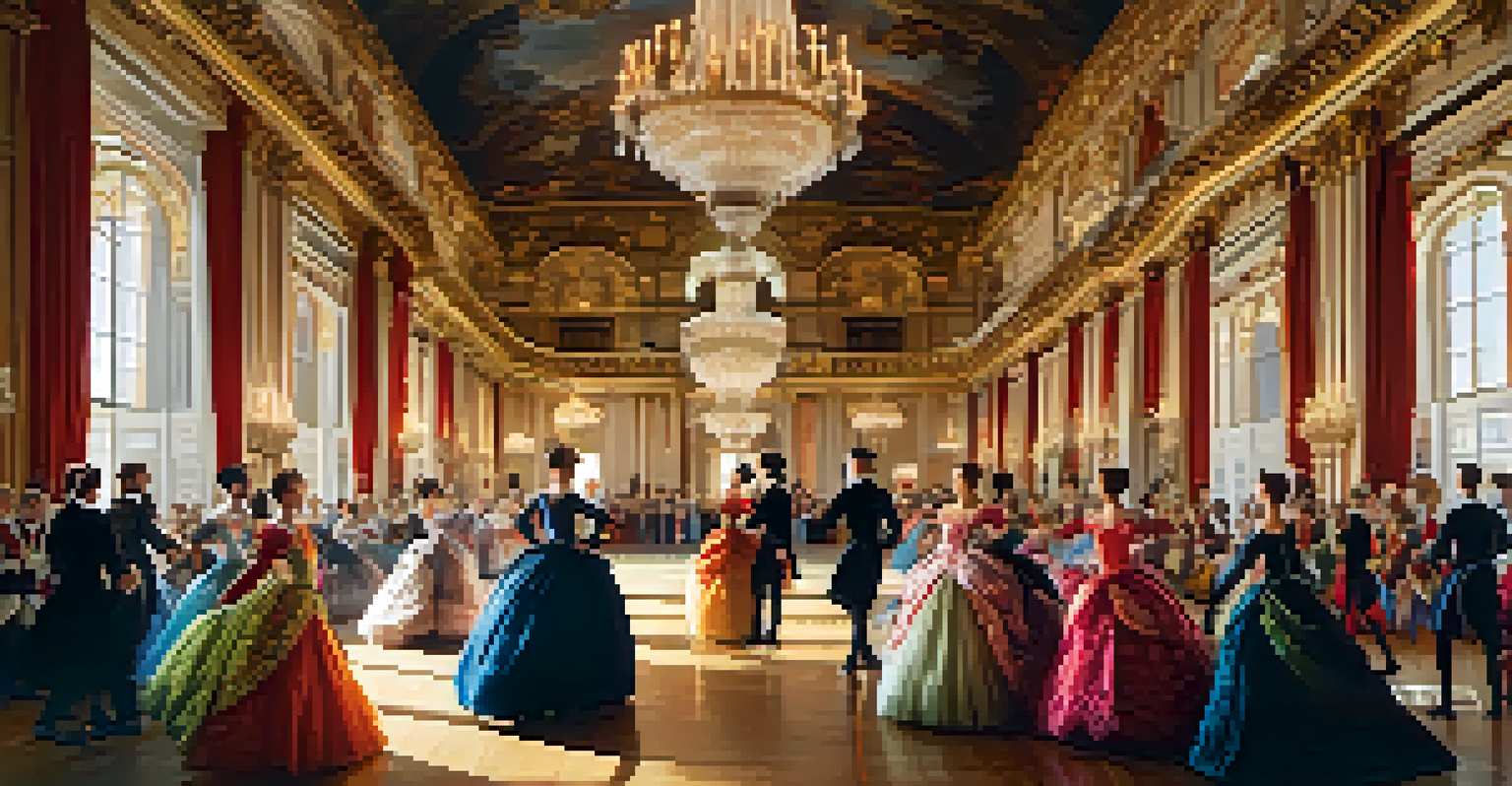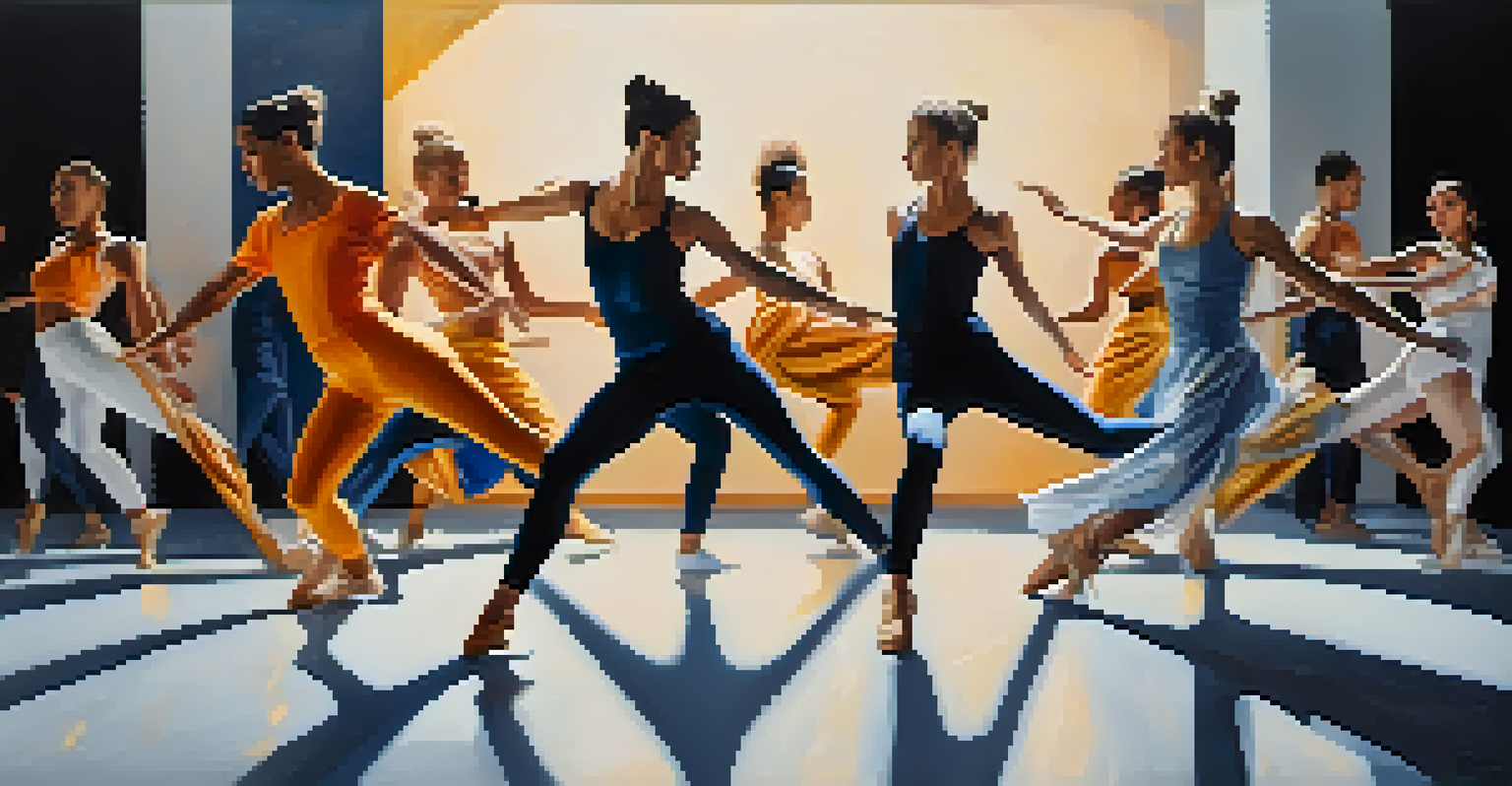Historical Evolution of Dance Costumes: A Visual Journey

The Ancient Roots of Dance Costumes and Their Significance
Dance has been a form of expression for centuries, and its costumes have deep cultural significance. In ancient civilizations, such as Egypt and Greece, clothing worn during performances was often adorned with symbols and colors representing deities and societal roles. These costumes not only enhanced the visual appeal but also connected dancers to the spiritual narratives of their time.
Dance is the hidden language of the soul.
For instance, the vibrant patterns of Egyptian dance attire were not merely decorative; they were imbued with meanings that transcended the physical realm. Similarly, Greek dancers wore flowing garments that accentuated their movements, making the performance a visual spectacle. This interplay between costume and culture laid the foundation for future evolutions in dance attire.
As we delve into the historical timeline, we see how these early costumes influenced later styles, establishing a rich tapestry of artistic expression that continues to inspire modern dance.
Medieval and Renaissance Influences on Dance Attire
As we move into the Medieval and Renaissance periods, dance costumes became more elaborate and reflective of societal norms. During the Medieval era, dancers often wore garments that were representative of their class, with nobles donning luxurious fabrics and intricate designs. This distinction not only showcased wealth but also indicated social status, making costume a vital element of dance.

The Renaissance brought about a flourishing of arts and culture, which was mirrored in the evolution of dance costumes. Dancers began to adopt more form-fitting attire, allowing for greater freedom of movement. The use of vibrant colors and elaborate embellishments became the norm, contributing to the theatricality of performances during this time.
Cultural Significance of Dance Costumes
Dance costumes have historically reflected cultural narratives and social status, evolving from ancient symbolism to modern expressions of individuality.
These changes in costume not only highlighted the dancers' movements but also reflected the broader cultural shifts. The merging of fashion and dance established a dynamic relationship that would continue to evolve in the following centuries.
The Baroque Period: Extravagance and Opulence in Dance Costumes
The Baroque period marked a time of extravagance, and this was vividly reflected in dance costumes. Dancers wore grand, ornate outfits characterized by intricate lace, heavy fabrics, and bold colors. This opulence underscored the theatrical nature of dance during this era, as performances became increasingly elaborate and choreographed.
Costume is the clothing of the dance; it is an integral part of the performance.
Baroque dancers often sported powdered wigs and accessories that added to the visual spectacle. The costumes were designed to capture the audience's attention, transforming dance into a form of high art. This emphasis on grandeur and detail influenced not only the performance style but also the way dance was perceived in society.
As we look back, it's clear that the Baroque period played a significant role in shaping the aesthetic standards of dance costumes, paving the way for future trends that continued to prioritize visual impact.
The Rise of Ballet and Its Impact on Dance Costumes
With the emergence of ballet in the 17th and 18th centuries, dance costumes underwent a significant transformation. Ballet attire, characterized by tutus and fitted bodices, was specifically designed to enhance the dancer's form and movements. This shift marked a departure from the ornate costumes of the Baroque era, emphasizing grace and fluidity instead.
The introduction of the Romantic ballet further evolved the costume design, with ethereal fabrics and flowing lines that evoked a sense of fantasy. Dancers began to wear delicate, lightweight materials that allowed for freedom of movement, while still maintaining an element of visual beauty. Costumes became a vital part of storytelling, helping to convey the emotions and themes of the performance.
Innovation in 20th Century Dance Wear
The 20th century saw a shift towards innovative and diverse dance costumes, breaking away from tradition to embrace personal expression and movement.
This evolution in ballet costumes not only set the stage for future dance forms but also established a standard for how costumes could enhance the narrative of a performance.
The 20th Century: Innovation and Diversity in Dance Costumes
The 20th century brought about a wave of innovation in dance costumes, reflecting the diverse styles and movements that emerged during this time. From jazz to modern dance, each genre adopted unique attire that suited its ethos and expression. Costumes became less about tradition and more about breaking boundaries, allowing dancers to explore their creativity.
For example, the flapper dresses of the jazz era were designed for movement, featuring fringe and sequins that swayed with every step. Meanwhile, modern dance ushered in a more minimalist approach, with simple, unstructured garments that emphasized the dancer's body and movement rather than elaborate designs. This shift highlighted the importance of personal expression in dance attire.
As we examine this era, it's clear that the diversity of dance costumes reflects the broader cultural shifts of the time, showcasing how fashion and dance continually influence one another.
Contemporary Dance: A Fusion of Styles and Individuality
Contemporary dance has embraced a fusion of styles, leading to a broad array of costume choices that reflect individual creativity. Dancers today often mix elements from various genres, creating unique looks that resonate with their personal expression. This has led to a democratization of dance attire, where comfort and practicality take precedence over tradition.
Costumes can range from casual athletic wear to elaborate designs, allowing for a wide spectrum of movement and style. The focus is often on how the costume complements the dancer's performance, adapting to the rhythm and energy of the piece. This versatility has redefined what dance costumes can be, making them an integral part of the performance.
Future Trends in Dance Attire
Advancements in technology and a focus on sustainability are shaping the future of dance costumes, promising creative and eco-friendly designs.
In this contemporary landscape, the relationship between dancer and costume is more collaborative than ever, emphasizing personal expression and breaking away from conventional norms.
The Future of Dance Costumes: Trends and Innovations Ahead
As we look to the future, the evolution of dance costumes continues to be shaped by technology and cultural shifts. Innovations such as 3D printing and smart fabrics are paving the way for new possibilities in costume design, allowing for greater creativity and functionality. Dancers can expect costumes that not only enhance their performance but also adapt to their movements in real-time.
Additionally, there is a growing emphasis on sustainability within the fashion industry, which is influencing dance attire as well. Designers are increasingly looking for eco-friendly materials and practices, creating a new standard for costumes that align with environmental values. This shift reflects a broader consciousness about the impact of fashion on the planet.

Ultimately, the future of dance costumes promises to be as dynamic and diverse as the art form itself, blending tradition with innovation to create visually stunning and meaningful attire.